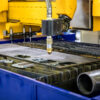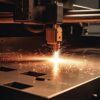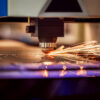The business landscape is constantly shifting, influenced by economic conditions, technological advancements, and industry demands. For laser cutting and CNC machining companies like Rapid Turn Laser & Machine in Houston, Texas, these changes present both challenges and opportunities. As the market adapts to new manufacturing trends, supply chain disruptions, and evolving customer needs, staying ahead of the curve has never been more critical.
This article explores the current business climate and how it affects laser cutting and CNC machining. We will discuss the economic factors shaping the industry, technological advancements driving innovation, the impact of supply chain fluctuations, and how businesses can thrive despite these challenges.
The Current Business Climate for Manufacturing
Economic Factors and Inflation
The past few years have seen significant economic fluctuations, affecting material costs, labor availability, and overall production expenses. Inflation has led to increased costs for raw materials such as aluminum, steel, and titanium—key components for laser cutting and CNC machining. This surge in prices forces manufacturers to adjust pricing models, optimize operations, and seek cost-efficient alternatives without compromising quality.
Houston’s industrial sector remains robust, but fluctuating energy prices and interest rates add uncertainty. For companies relying on CNC machining and laser cutting, maintaining competitive pricing while ensuring high-quality outputs is a delicate balancing act.
Supply Chain Challenges and Resilience
The global supply chain disruptions caused by the pandemic and geopolitical tensions continue to impact manufacturing. Delays in raw material shipments and increased shipping costs can hinder production timelines, making it essential for businesses to build resilience through diversified supply chains.
Companies like Rapid Turn Laser & Machine can mitigate these disruptions by establishing relationships with multiple suppliers, investing in local sourcing options, and implementing just-in-time inventory strategies to reduce dependency on uncertain global markets.
Technological Advancements in Laser Cutting and CNC Machining
Increased Automation and Smart Manufacturing
Automation and artificial intelligence (AI) are transforming the manufacturing sector. CNC machining and laser cutting operations are benefiting from advanced robotics, machine learning, and real-time monitoring. These innovations increase efficiency, reduce labor costs, and enhance precision.
Automated laser cutting systems now feature adaptive controls, allowing for more intricate and precise cuts. Similarly, CNC machining has evolved with predictive maintenance technology, ensuring machines operate at peak performance while minimizing downtime.
The Role of Industry 4.0 in Modern Manufacturing
Industry 4.0, the fourth industrial revolution, integrates smart technologies into manufacturing. The Internet of Things (IoT) enables real-time monitoring of CNC machines, predictive maintenance, and seamless integration between design and production.
Cloud-based software solutions also improve workflow efficiency, allowing manufacturers to streamline operations, reduce errors, and enhance productivity. Companies investing in these digital transformations will remain competitive in an evolving business environment.
Industry Trends Shaping the Future
Growth in Aerospace, Automotive, and Energy Sectors
Houston’s manufacturing industry is deeply tied to aerospace, automotive, and energy sectors—all of which rely heavily on precision machining and laser cutting. With advancements in electric vehicles (EVs) and renewable energy projects, the demand for CNC-machined components is on the rise.
Aerospace manufacturing is also seeing increased investment, requiring lightweight yet durable components. Precision laser cutting is crucial for creating intricate aerospace parts, making it a key player in the industry’s expansion.
Customization and On-Demand Manufacturing
Customers are demanding more customized solutions, leading to a shift toward on-demand and small-batch manufacturing. CNC machining and laser cutting companies must adapt by offering flexible production capabilities, allowing for rapid prototyping and short-run manufacturing without excessive costs.
Customization also extends to material selection, with clients seeking specialized alloys and composites tailored to their specific applications. Companies that can efficiently handle these demands will gain a competitive edge in the marketplace.
How Businesses Can Adapt and Thrive
Investing in Workforce Development
The manufacturing sector faces a growing skills gap, with a shortage of trained professionals in CNC machining and laser cutting. Investing in workforce training programs, apprenticeships, and upskilling initiatives is crucial for businesses to maintain high-quality production standards.
Houston’s strong network of technical schools and vocational training programs provides an excellent opportunity for businesses to collaborate with educational institutions to cultivate a skilled workforce.
Enhancing Sustainability Practices
Sustainability is a growing concern for manufacturers. Companies are adopting eco-friendly practices such as reducing waste, recycling materials, and optimizing energy consumption. Laser cutting technology, for example, has become more efficient, producing minimal waste while maximizing material utilization.
By implementing green manufacturing initiatives, businesses can reduce costs and appeal to environmentally-conscious customers, further strengthening their brand reputation.
The evolving business climate presents both challenges and opportunities for CNC machining and laser cutting companies. By embracing technological advancements, optimizing supply chain strategies, investing in workforce development, and enhancing sustainability efforts, businesses can navigate these changes successfully.
For Rapid Turn Laser & Machine, staying ahead of industry trends and leveraging smart manufacturing solutions will ensure long-term success in Houston’s competitive market. By adapting to the new business climate, companies can thrive, offering precision, quality, and efficiency to meet the growing demands of their clients.








